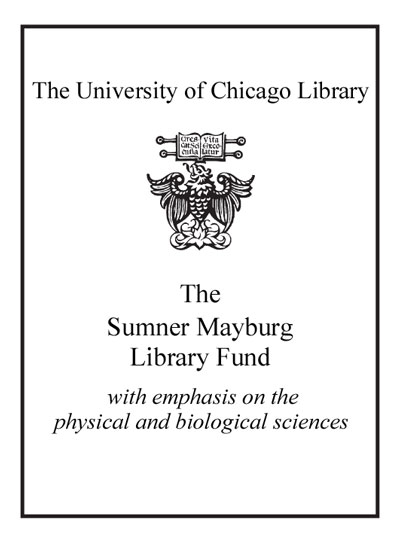DNA virus replication /
Saved in:
| Imprint: | Oxford ; New York : Oxford University Press, c2000. |
|---|---|
| Description: | xvi, 232 p. : ill. ; 25 cm. |
| Language: | English |
| Series: | Frontiers in molecular biology ; 26 |
| Subject: | |
| Format: | E-Resource Print Book |
| URL for this record: | http://pi.lib.uchicago.edu/1001/cat/bib/4562750 |
Table of Contents:
- List of contributors
- Abbreviations
- 1. Macromolecular interactions in hepatitis B virus replication and particle assembly
- 1.. Introduction
- 2.. The HBV infectious cycle
- 3.. Experimental systems to study HBV replication
- 3.1. Animal models
- 3.2. Transfection of cloned hepadnavirus DNA
- 3.3. Reconstituting hepadnavirus reverse transcription in vitro
- 4.. Assembly of virus particles
- 4.1. Envelope containing particles
- 4.2. The nucleocapsid
- 5.. The enigma of HBx
- 6.. Conclusions and perspectives
- Acknowledgements
- References
- 2. Protein-protein interactions in papillomavirus replication
- 1.. Introduction
- 2.. Early HPV proteins
- 2.1. HPV-16 E6
- 2.2. HPV-16 E7
- 2.3. HPV-16 E5
- 2.4. Summary of the roles of E6, E7, and E5 in keratinocyte differentiation and cell cycle control
- 3.. Viral proteins involved in viral DNA replication
- 3.1. E1 and E2 proteins
- 3.2. Maintenance and amplification of HPV genomes
- 4.. Summary
- Acknowledgments
- References
- 3. Molecular interactions in herpes simplex virus DNA replication
- 1.. Introduction
- 2.. Identification of the cis-acting signals and trans-acting proteins involved in HSV-1 DNA synthesis
- 3.. Models for HSV-1 DNA replication
- 4.. Molecular interactions involved in HSV-1 DNA synthesis
- 5.. Interactions involved in unwinding the replication origins
- 5.1. ICP8
- 5.2. HSV-1 DNA replication origins
- 5.3. Interaction of UL9 with the viral origins
- 5.4. DNA helicase activity of UL9 and interaction with ICP8
- 5.5. Unwinding of the replication origins
- 5.6. Regulation of origin activity
- 6.. Interactions involved in the initiation of DNA synthesis
- 6.1. The helicase--primase complex
- 6.2. Effect of ICP8 on the helicase--primase complex
- 6.3. The HSV-1 DNA polymerase holoenzyme
- 6.4. Interaction between UL8 and UL9
- 6.5. Interactions of the HSV-1 DNA polymerase with UL8 and UL9
- 6.6. Interaction of host DNA polymerase [alpha] with UL9
- 7. A model for the establishment of the HSV-1 replication fork
- 8. Other interactions involving HSV-1 ICP8
- 9.. Intranuclear localization of HSV-1 DNA synthesis
- 10.. Concluding remarks
- References
- 4. Epstein--Barr virus proteins involved in cell immortalization
- 1.. Introduction
- 2.. The nuclear proteins expressed in EBV-transformed B cells
- 2.1. The EBV nuclear antigen-1, EBNA1
- 2.2. The EBV nuclear antigen-2, EBNA2
- 2.3. The EBV leader protein, EBNA-LP
- 2.4. The EBV nuclear antigen-3 family, EBNA3A, EBNA3B, and EBNA3C
- 3.. Latent membrane proteins expressed in EBV-transformed B cells
- 3.1. The latent membrane protein-1, LMP1
- 3.2. The latent membrane protein-2, LMP2
- 4.. Conclusions
- References
- 5. Molecular piracy by KSHV: a strategy of live and let live
- 1.. Introduction
- 2.. KSHV as a model for molecular piracy
- 3.. Immunomodulatory proteins encoded by KSHV
- 3.1. Viral interleukin-6 (vIL-6)
- 3.2. Viral macrophage inflammatory proteins (vMIPs)
- 3.3. Viral G protein-coupled receptor (vGCR)
- 3.4. Viral interferon regulatory factor (vIRF)
- 4.. KSHV proteins affecting the cell cycle and apoptosis
- 4.1. Viral cyclin (v-Cyc)
- 4.2. Viral Bcl-2 (vBcl-2)
- 4.3. Viral FLIP (vFLIP)
- 5.. Novel ORFs encoded by KSHV
- 5.1. ORF K1
- 5.2. Kaposin
- 6.. Conclusions
- Acknowledgements
- References
- 6. Cellular sites and mechanisms of human cytomegalovirus latency
- 1.. Introduction
- 2.. Cells of the myeloid lineage are an important site of carriage of HCMV
- 3.. Viral gene expression associated with latency
- 4.. Permissiveness of peripheral blood cells for HCMV infection requires differentiation
- 5.. Bone marrow--a reservoir of virus in the healthy carrier
- 6.. Conditionally permissive cell lines as models for factors controlling latency and reactivation
- 7.. Many cell types are infected during viraemia--does this reflect other sites of latency?
- 8.. Conclusions
- Acknowledgements
- References
- 7.. Control of transcription by adenovirus-E1A proteins
- 1.. Introduction
- 2.. The adenovirus E1A proteins
- 3.. Transcriptional regulation
- 3.1. Regulation of transcription initiation
- 4.. Binding of E1A to the retinoblastoma and related proteins
- 4.1. Effect of pocket proteins on E2F
- 4.2. Binding of pRb to other cellular proteins
- 5.. Binding of E1A to p300 and related proteins
- 5.1. Role of p300/CBP in transcription regulation
- 5.2. The intrinsic and associated acetyltransferase activity of p300/CBP
- 5.3. Role of p300/CBP in cell growth and differentiation
- 5.4. Role of the individual p300/CBP members
- 6.. Other proteins associating with E1A
- Acknowledgements
- References
- 8.. Adenovirus proteins that regulate apoptosis
- 1.. Introduction
- 2.. Course of adenovirus infection
- 3.. E3-coded proteins that inhibit immune-mediated apoptosis
- 4.. Induction of apoptosis by E1A
- 5.. Inhibition of apoptosis by the E1B-19K protein
- 6.. Inhibition of apoptosis by the E1B-55K protein
- 7.. Apoptosis regulation by E4 proteins
- 8.. Inhibition of the antiviral effects of interferons
- 9.. Induction of cell lysis and virus release by the adenovirus death protein (ADP)
- 10.. Concluding remarks
- Acknowledgements
- References
- Index


